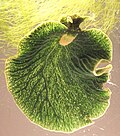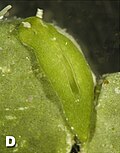Kleptoplasty or kleptoplastidy is a process in symbiotic relationships whereby plastids, notably chloroplasts from algae, are sequestered by the host....
16 KB (1,589 words) - 08:07, 14 June 2024
Despite being animals, they indirectly perform photosynthesis, via kleptoplasty. Discovered in 1993 off the coast of the Japanese island Kuroshima, Costasiella...
5 KB (441 words) - 23:20, 27 January 2025
chloroplasts from the algae they eat, a very unusual phenomenon known as kleptoplasty, for the "stolen" plastids. This earns them the title of the "solar-powered...
24 KB (2,691 words) - 04:44, 29 July 2024
which incorporate functioning chloroplasts into their tissues using kleptoplasty Species of aeolid nudibranchs in the genera Phyllodesmium and Pteraeolidia...
486 bytes (85 words) - 16:12, 11 July 2019
The capture and sequestering of photosynthetic cells and chloroplasts, kleptoplasty, occurs in many types of modern eukaryotic organisms. The cytoskeleton...
63 KB (6,280 words) - 20:03, 29 January 2025
Rapaza (section Chloroplasts and kleptoplasty)
retains the chloroplasts of its prey for its own use, a process known as kleptoplasty ('stealing of plastids'). After phagocytosis of the algal prey, its cell...
16 KB (2,303 words) - 02:26, 20 May 2024
chloroplasts from the algae they eat for photosynthesis, a phenomenon known as kleptoplasty. Elysia chlorotica is one species of such "solar-powered sea slugs"....
19 KB (2,187 words) - 08:32, 26 June 2024
Elysia atroviridis (section Kleptoplasty)
capable of kleptoplasty, which is the process of taking chloroplasts from digested algae and using them for photosynthesis. Kleptoplasty is performed...
7 KB (685 words) - 15:31, 27 June 2024
Elysia crispata (section Kleptoplasty)
quickly, with little chloroplast retention. Upon reaching maturity, kleptoplasty becomes an important energy source. The primary food source of E. crispata...
10 KB (1,149 words) - 18:32, 6 January 2024
developed the capacity to sequester ingested plastids—a process known as kleptoplasty. A. F. W. Schimper was the first to name, describe, and provide a clear...
29 KB (3,273 words) - 23:28, 12 January 2025
Elysia pusilla (section Kleptoplasty)
before hatching. Sacoglossa are the only metazoans on earth to exhibit kleptoplasty. The only other organisms known to have this ability are single celled...
16 KB (1,903 words) - 22:57, 15 January 2024
S2CID 91740559. Stephenson, India (2017). Species discovery, evolution and kleptoplasty in marine meiofaunal flatworms (MSc). University of British Columbia...
2 KB (121 words) - 19:35, 28 January 2023
supplement its own biochemical capabilities. In the related process of kleptoplasty, the predator sequesters plastids (especially chloroplasts) from dietary...
2 KB (212 words) - 17:30, 17 January 2025
lettuce-like ruffles that line its body. This slug, like other Sacoglossa, uses kleptoplasty, a process in which the slug absorbs chloroplasts from the algae it eats...
10 KB (1,205 words) - 11:57, 6 December 2024
providing the chloroplasts. And there are those that acquire them through kleptoplasty, or through symbiotic associations with prey, or through 'enslavement'...
18 KB (1,688 words) - 02:04, 29 December 2024
diatoms. Some species also perform kleptoplasty: Dinophysis have plastids from a cryptomonad, due to kleptoplasty from a cilate prey. The Kareniaceae...
97 KB (10,439 words) - 16:09, 26 January 2025
bioluminescent ostracods, including Cypridina noctiluca or Vargula hilgendorfii. Kleptoplasty Bessho-Uehara, Manabu; Yamamoto, Naoyuki; Shigenobu, Shuji; Mori, Hitoshi;...
2 KB (152 words) - 17:10, 6 May 2024
chloroplasts, and those with endosymbionts—and others that acquire them through kleptoplasty or by enslaving the entire phototrophic cell. The distinction between...
77 KB (7,109 words) - 18:36, 22 December 2024
Costasiella ocellifera (section Kleptoplasty/feeding)
ocellifera.Costasiella ocellifera shows long-term retention of functional kleptoplasty. The name 'ocellifera' comes from the Latin word for eye, ''ocellus''...
18 KB (2,041 words) - 00:49, 13 April 2024
and feeds on Bryopsis algae off the rocky bottom. E. marginata uses kleptoplasty to sequester the chloroplasts from the algae it consumes. These chloroplasts...
5 KB (566 words) - 17:19, 4 September 2024
sanguinea Euglena, moving by metaboly and swimming Elysia chlorotica Kleptoplasty "The Euglenoid Project: Alphabetic Listing of Taxa". The Euglenoid Project...
29 KB (3,064 words) - 20:48, 2 December 2024
the oxygen produced by algal photosynthesis. Some protozoans practice kleptoplasty, stealing chloroplasts from prey organisms and maintaining them within...
52 KB (5,232 words) - 23:32, 21 January 2025
microalgae has evolved. Some species in the same order has also evolved kleptoplasty. The earliest known fossils confidently classified as tapeworms have...
64 KB (6,631 words) - 16:44, 12 December 2024
the only eukaryotes outside Diaphoretickes to do so without performing kleptoplasty, and so obtain energy through photosynthesis. These chloroplasts are...
26 KB (1,770 words) - 17:22, 23 October 2024
capture from the algae in their diet and then store in their bodies (see Kleptoplasty). This allows the mollusks to survive solely by photosynthesis for several...
109 KB (11,760 words) - 03:46, 28 January 2025
the chloroplasts for their own photosynthetic use, a process known as kleptoplasty. Some of these species have been observed practising autotomy, severing...
43 KB (4,387 words) - 21:25, 10 December 2024
some other Sacoglossan species carry out a process called functional kleptoplasty. This is a process in which the digestion of algal plastids consumed...
7 KB (686 words) - 14:13, 7 April 2024
except for the plastids, which continue to perform photosynthesis (kleptoplasty). Recognition of the importance of mixotrophy as an ecological strategy...
62 KB (6,471 words) - 03:50, 25 January 2025
chloroplasts from other sources, including tertiary endosymbiosis and kleptoplasty. Most dinoflagellates are free-living and compose an important portion...
207 KB (20,852 words) - 16:17, 1 February 2025
(kléptein), κλέπτης (kléptēs) kleptocracy, kleptomania, kleptophobia, kleptoplasty ktet- possession, ownership Greek κτητικός (ktētikós), κτήτωρ (ktḗtōr)...
3 KB (36 words) - 23:44, 12 March 2024

























